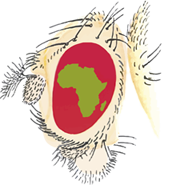Article in The Guardian
Submitted by linceA small institute in Kampala is cultivating a regional network of researchers, using an inexpensive lab model based on the fruit fly.
(This article origanally appeared in the Guardian site)
African biomedical scientists face important challenges – poor training, poorer infrastructure and scarce resources. This means most research is through epidemiological studies or using laboratory rats. Neither methodology address the cellular and molecular underlying physiological processes or diseases, or teach junior scientists how to carry out hypothesis-driven science.
As a result, the African research agenda is mostly set by well-intended funders living far away from the African reality. Local researchers are most often ignored, sometimes used as a token in “collaborative” grants. Those on ground have little to no decision-making power and the biggest part of the resources return to the west where they originated.
We believe the Drosophila melanogaster (fruit flies) can empower the scientists of Africa to pursue their research interests. Drosophila transformed the scientific scene in Spain decades ago, when limited resources called for an inexpensive laboratory model.
Three Spanish researchers founded DrosAfrica to train a community of researchers to use fruit flies to investigate biomedical questions. This species of fly has been instrumental for developmental biology, genetics and biomedical research. The flies have played a role in identifying genes that relate to the immune system, cancer, Alzheimer’s and Parkinson’s diseases and are an invaluable tool in teaching research, the scientific method and critical thinking.
In 2012, I moved to Uganda to establish a research lab at Kampala International University (KIU). Resources are scarce and recruiting qualified staff is mission impossible. The lab is dusty and power is erratic. Back then, very few knew of the existence of Drosophila, but now we have Nigerians, Kenyans and Ugandans discussing with this Spaniard how to test the long-term effects of repeated exposure to some drugs using flies.
In two workshops we have trained 27 people (17 Nigerians, three Kenyans, and four Ugandans). Our alumni are using flies for their PhD projects and leading budding research groups in Uganda and Nigeria. We have also established contact with other institutions and in 2016 we will run workshops at universities in Kenya and Nigeria.
Raising funds for building capacity is a challenge. Funders want clean water for all, or the cure for malaria, but forget to build the capacity that will enable African scientists to compete for research funds to solve Africa’s health problems. The few agencies that fund workshops give small amounts to partially cover expenses. If we don’t cover travelling costs for participants, we will be limited to the local audience. Luckily, Kampala university has attracted an international faculty to work with and our initial efforts can expand with the return home of our alumni.
Two years after the first workshop we have an established graduates who have done high quality research with their own hands without leaving the continent, and our alumni are training others. We want to do more workshops. We want to establish fly rooms all over sub-Saharan Africa. The resources needed to start up a fly lab are small, but potential benefits are huge: deep knowledge and profound discoveries. We think that Drosophila can lead the take-off of African biomedical research.
Marta Vicente-Crespo is a co-founder of DrosAfrica and director of the Institute of Biomedical Research at Kampala International University.
A few comments on the article:
Genetic Society of America (https://www.facebook.com/GeneticsGSA/posts/877055989016267)
Alfonso Martínez Arias (https://twitter.com/AMartinezArias/status/634613660787339264)
Menéame (https://www.meneame.net/m/cultura/puede-humilde-mosca-fruta-ayudar-crear...)
